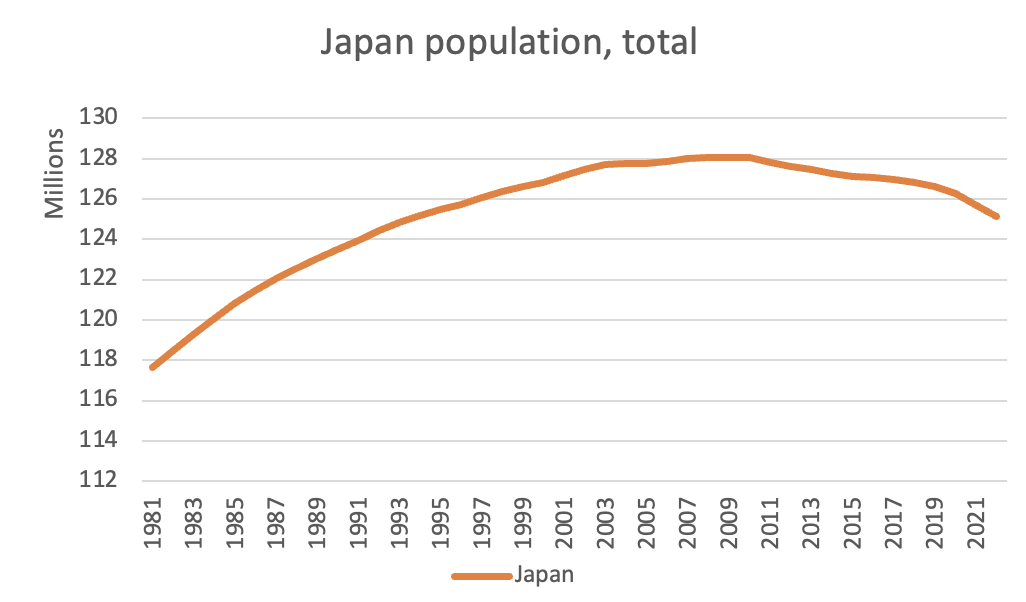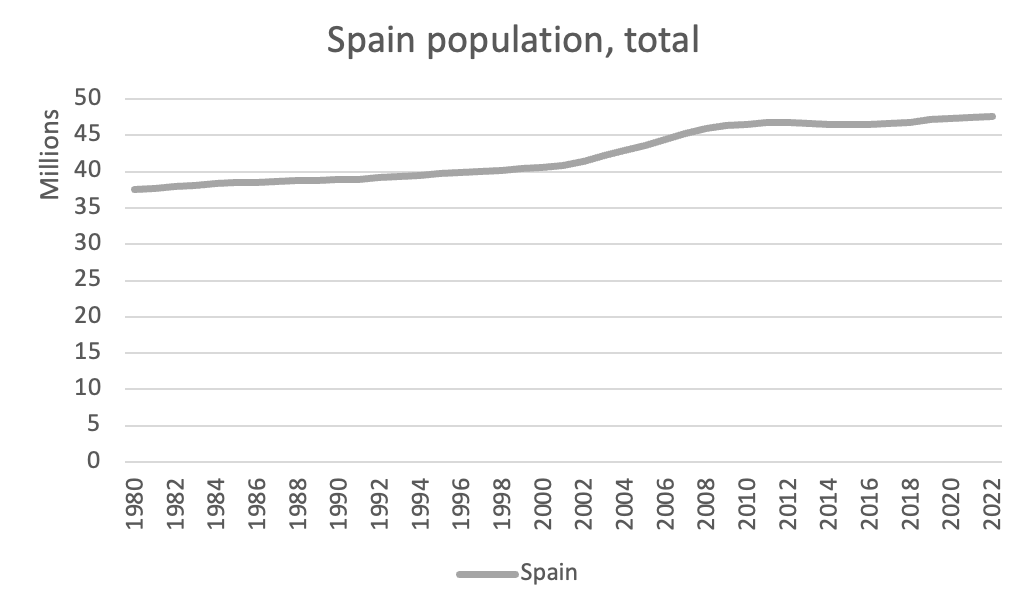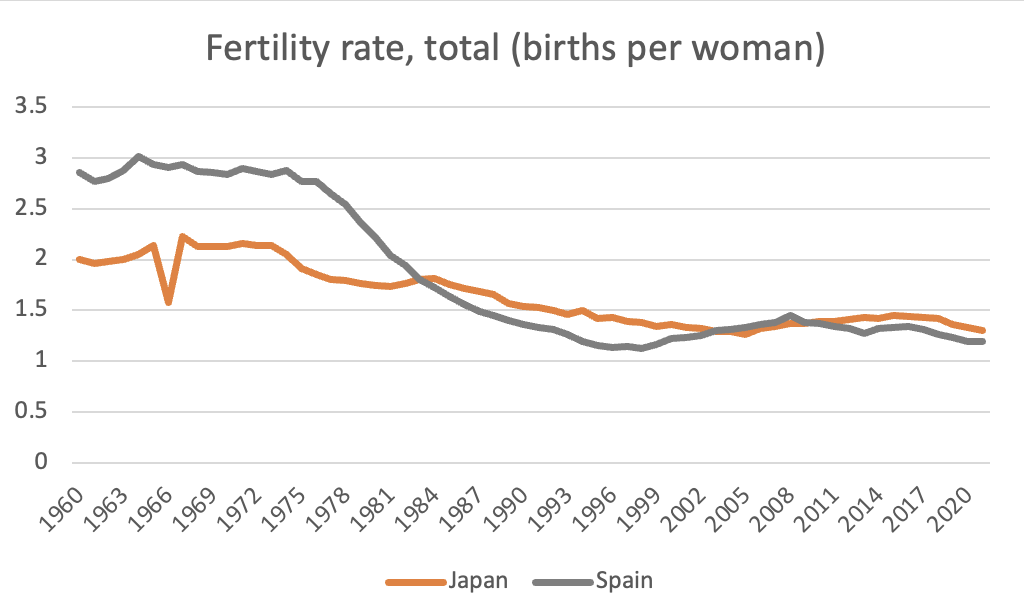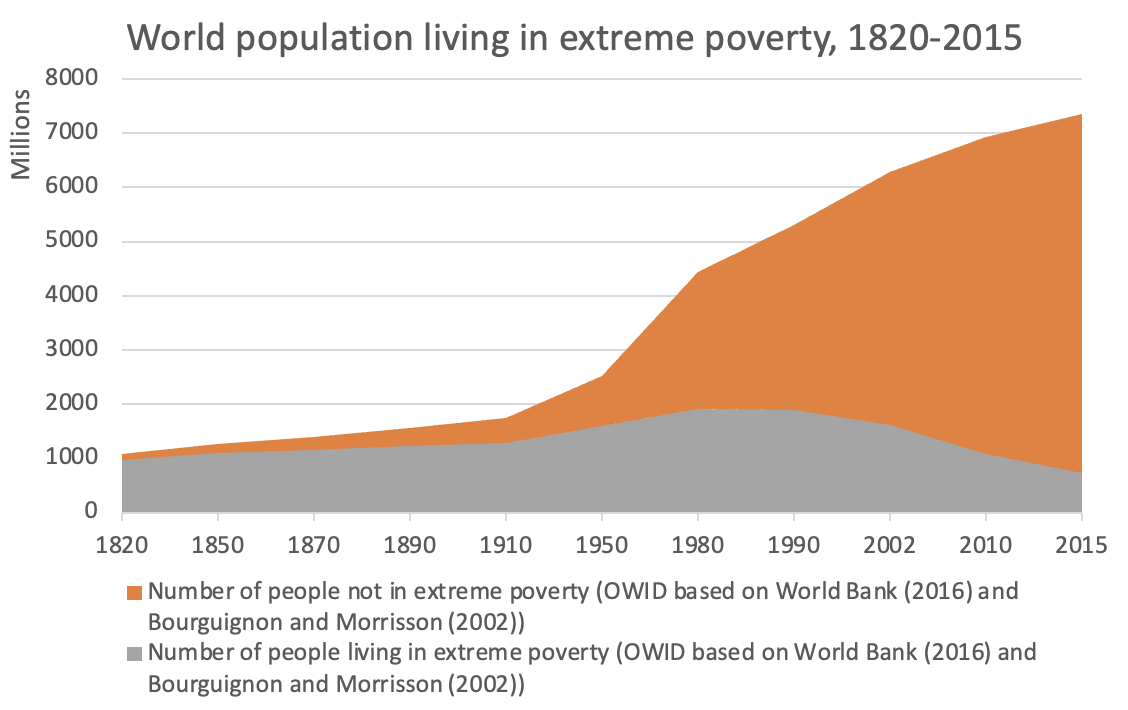
The world is now witnessing one of the most momentous and consequential changes in centuries. It puts the social importance of artificial intelligence (AI) revolution in a different light.
It can take forever to get a doctor’s appointment with a specialist. China is no longer the most populous country, its population is falling, and that decline will continue. Restaurants are investing in robots because it is so tough to get help.
One can point to many reasons for each of these. Doctor burnout. The pandemic. Immigration restrictions. And what do you expect when you tell women for decades that they can have just one kid?
These are the canaries in the coal mine. For many years, women, in many developed countries, haven’t been having enough babies to even keep the population level, much less growing. They need to produce about 2.1 over their lifetimes. Based on data for the last couple of years, the U.S. fertility rate is 1.7, the EU’s is 1.5, Japan is 1.3, China, is 1.1, and South Korea is 0.8. Lesser developed countries are usually above 2.1, but even their fertility rates have been falling.
It takes a while for these depressed fertility rates to show up in population statistics. Japan hasn’t been above 2.1 since 1974, but its population went in reverse around 2012. Spain’s fertility rate fell below 2.1 around 1981 and is now at 1.2; its population dipped around 2012 and has remained roughly flat since, helped by immigration. The long-term trends seen in Japan and Spain are emblematic of what’s happening in developed economies.



The U.S. is in a better situation compared with other countries. The fertility rate fell below 2.1 in 2009 and has declined since, reaching 1.66 in 2023. The Congressional Budget Office predicts that immigration will make up enough of the shortfall to at least keep the population growing through 2053, although at lower rates than historically. The U.S. will have an estimated 373 million people in 2053, up from 336 million in 2023. That’s a paltry 0.3% growth compared to the 0.8% growth between 1988 and 2022. By 2042, all further growth in the U.S. population is forecast to come from immigration.

Like climate change, these dramatic changes in the world are largely baked in and hard to reverse within decades. Each cohort has fewer babies than the last because it is smaller. Unless women start having substantially more than two kids on average it is hard to dig out of the deficit. Short of apocalyptic scenarios, it is also hard to imagine that the underlying factors that have caused declining birth rates, such as urbanization, will reverse themselves, or that public policies, such as subsidies for having kids, could make enough of a difference.
The demographic debacle is up there with climate change when it comes to the challenges faced by humanity. At a high level, there are fewer working-age people able to support the older population, especially as mortality rates decline, ballooning the older cohorts while the younger ones shrink.
Unless technological change comes to the rescue, the ramifications of the decline in fertility rates to well below 2.1 are far reaching and immense. Governments have to raise taxes on a declining workforce, or a shrinking economy, or slash social programs. Business will have to get used to slower growing demand, older demographics and fewer employees. Consumers who have seen their standards of living rising for centuries will need to adjust their expectations. And all these, and other, consequences feed on each other, not in good ways.
Older readers may find their heads spinning. The dire predictions of not many decades ago — and Thomas Malthus in 1798 — was that exploding populations would put the world in misery as too many people chased too few resources. “Population control, or race to oblivion” said the cover of the 1968 best seller, The Population Bomb. So, it must be good that we will have even fewer people doing so.
History doesn’t support that. Living standards have grown rapidly over the last few centuries globally while population has also risen sharply. One reflection of that is that the share of people living in extreme poverty has plummeted; in the last several decades, the number of people in that sad state have declined sharply while total population has risen. The dire predictions didn’t come to pass and theories and statistics they were based on have been discredited.

Economists have found that increasing population can raise economic growth because there are more working age people, and output per worker increases when interactions among more people lead to more innovation. And the reverse happens when population growth slows. A recent working paper, co-authored by a leading economic demographer, forecast that almost all OECD countries, and 70 countries in total, will experience lower economic growth as a result of the decline in fertility rates between 2020-2050. The study was based on a model estimated with data from 1950-2015.
Fortunately, there are now reasons to be optimistic that the demographic debacle, with stagnant and declining living standards, won’t come to pass. Technological change has come to the rescue. The miracle of artificial intelligence happened just in time.
Artificial intelligence has been in the works for about 75 years. It made slow progress, with fits and starts, intermittent claims that machines would soon substitute for humans, only to have hopes dashed in the face of daunting challenges. In 2017, there was a critical breakthrough that introduced the transformer architecture. That led to Generative Pre-Trained Transformers (GPTs), which are trained using massive datasets to generate content that is similar to what humans can produce. Innovations in chip design and cloud computing provided the fast processing needed for this training.
In November, OpenAI introduced ChatGPT, which it claimed can “answer followup questions, admit its mistakes, challenge incorrect premises, and reject inappropriate requests.” As users soon learned, it could also spit out crisply worded essays on just about anything.
Improvements in AI are happening very quickly. An updated version of ChatGPT, introduced in March, can write songs, screenplays and software programs. The new version, based on GPT-4, did much better than GPT-3 on the uniform bar exam in the U.S., moving from placing in the 10th percentile of test takers the 90th percentile. Wharton researchers report that GPT-4 is much better and far faster than MBA students in generating business ideas, based on consumer evaluations of both their outputs.
ChatGPT proved that AI technologies, combined with vast amounts of data and enormous computing power, can equal or excel humans at many tasks and do things that no human could contemplate doing. It marks the beginning of a revolution in which artificial intelligence will be able to substitute for human intelligence in a wide range of applications throughout the economy. This will happen rapidly given the pace of innovation in AI technologies, the ability of foundational models to support applications created by entrepreneurs, and the ability of AI technologies to generate efficiencies in so many tasks that rely on human intelligence.
The artificial intelligence miracle may be able to avert the demographic debacle, or at least temper it effects. AI is not just another technological innovation like the cotton gin or word processing that saves people time, although it can do that too. It appears likely that AI will be able to generate increasingly close substitutes to human brains. It remains to be seen whether AI technologies will be able to make discoveries, like quantum mechanics, on their own. Even it never reaches that level, AI might help human inventors reach higher levels of creativity and productivity.
The bar for fully reversing the long-term effects of declining fertility rates is high. In some countries it is roughly equivalent to doubling the number of births and subsequent entrants into the workforce. The economics of AI should make us optimistic that this could happen. The fixed costs of developing models that can mimic human intelligence are very high, but the marginal costs of human-brain substitutes are very low. AI tools can be made available at a low distribution cost to anyone, anywhere, anytime with an internet connection. As with all knowledge-generating activities, the output of AI models is non-rivalrous: One person’s consumption does not reduce another person’s consumption (putting aside the computational resources for running iterations of the model). AI tools such as GPT-4 are similar to algorithms such as search engines in that they learn, and get better and more precise, from being used to do more things by more people and ingesting more data.
Depopulating the planet may have adverse effects, including on human creativity that AI may not be able to replace, or creativity needed to advance AI. Society should not give up on making and raising babies. Governments should be looking at policies nudge the fertility rate up. Pursuing their narrow self-interest, countries with low fertility rates should be encouraging immigration to keep their populations growing.
Humankind can, however, probably breath a collective sigh of relief that drastic technological change will probably help us dodge a bullet.